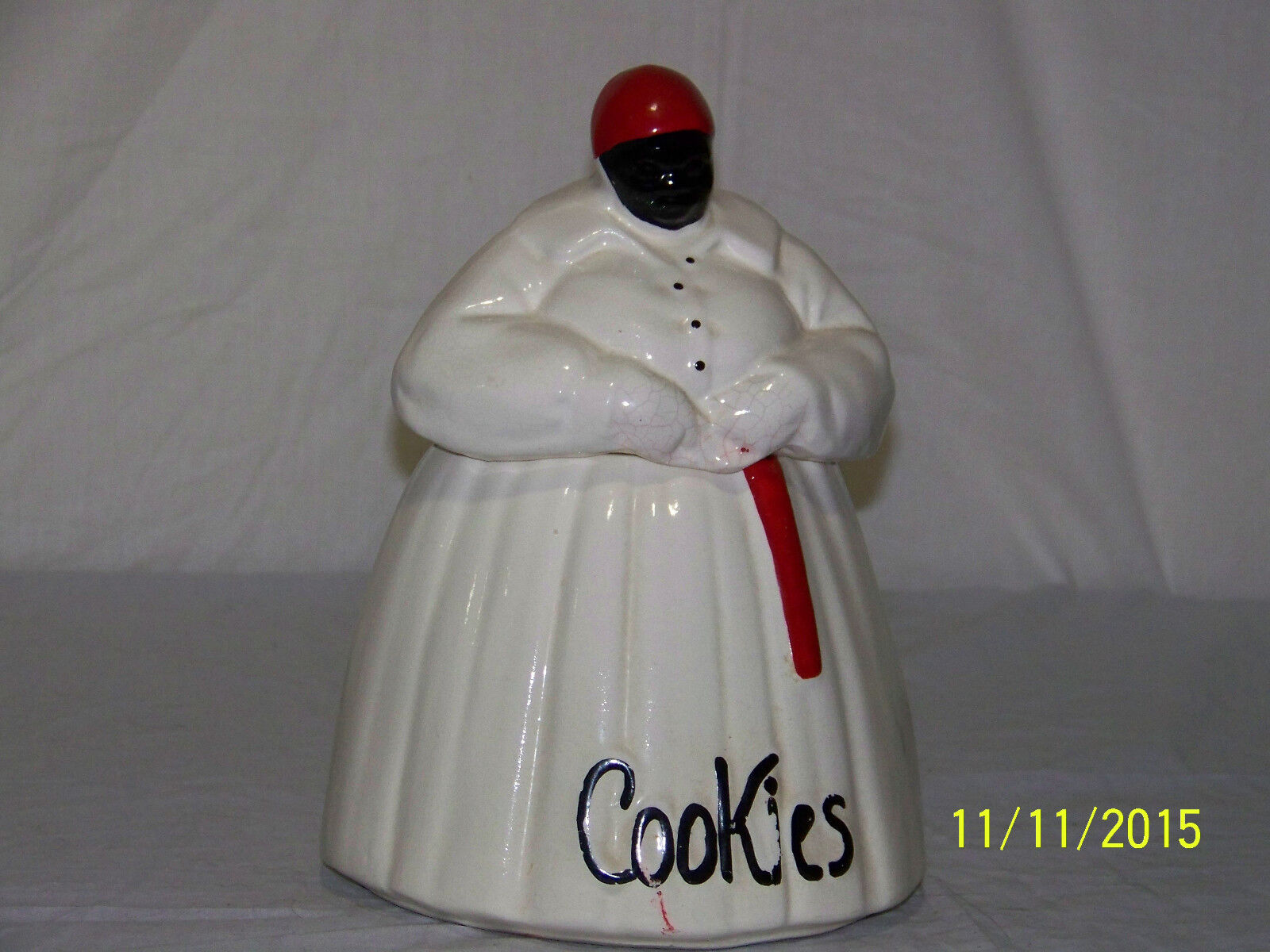Vintage McCoy Art Pottery Aunt Jemima Cookie Jar

When you click on links to various merchants on this site and make a purchase, this can result in this site earning a commission. Affiliate programs and affiliations include, but are not limited to, the eBay Partner Network.
Vintage McCoy Art Pottery Aunt Jemima Cookie Jar:
$345.00
Vintage McCoy American Art Pottery Aunt Jemima Cookie Jar. McCoy inscribed on bottom of jar. Some wear to the back ribbon on the head area, some crackle on front, slight wear to \"Cookies\" on front. . EXCELLENT CONDITION! MEASURES: 11\" x 8\". PLEASE WAIT FOR INVOICE!-------------------------The inspiration for Aunt Jemima was Billy Kersands\' American-style minstrelsy/vaudeville song \"Old Aunt Jemima\", written in 1875. The Aunt Jemima character was prominent in minstrel shows in the late 19th century and was later adopted by commercial interests to represent the Aunt Jemima brand.
St. Joseph Gazette editor Chris L. Rutt, of St. Joseph, Missouri, and his friend Charles G. Underwood bought a flour mill in 1888. Rutt and Underwood\'s Pearl Milling Company faced a glutted flour market, so they sold their excess flour as a ready-made pancake mix in white paper sacks with a trade name (which Arthur F. Marquette dubbed the \"last ready-mix\".
Rutt reportedly saw a minstrel show featuring the \"Old Aunt Jemima\" song in the fall of 1889, presented by blackface performers identified by Marquette as \"Baker & Farrell\". However, Doris Witt was unable to confirm Marquette\'s account. Witt suggests that Rutt might have witnessed a performance by the vaudeville performer Pete F. Baker, who played a character described in newspapers of that era as \"Aunt Jemima\". If this is correct, the original inspiration for the Aunt Jemima character was a white male in blackface, whom some have described as a German immigrant.Marquette recounts that the actor playing Aunt Jemima wore an apron and kerchief, and Rutt appropriated this Aunt Jemima character to market the Pearl Milling Company pancake mix in late 1889 after viewing a minstrel show. However, Rutt and Underwood were unable to make the project work, so they sold their company to the Randolph Truett Davis Milling Company in St. Joseph, Missouri, in 1890.The R. T. Davis Milling Company hired former slave Nancy Green as a spokesperson for the Aunt Jemima pancake mix in 1890. Nancy Green was born in Montgomery County, Kentucky, and played the Jemima character from 1890 until her death on September 23, 1923. As Jemima, Green operated a pancake-cooking display at the World\'s Columbian Exposition in Chicago, Illinois, USA in 1893, appearing beside the \"world\'s largest flour barrel\". From this point on, marketing materials for the line of products centered around the stereotypical mammy archetype, including the Aunt Jemima marketing slogan first used at the World Fair: \"I\'s in Town, Honey\". Anna Julia Cooper used the World\'s Columbian Exposition as an opportunity to address how young African American women were being exploited by white men. She predicted the appeal of Aunt Jemima and the southern domestic ideal and went on to describe the north\'s fascination with southern traditions as part of America’s “unwritten history”.Progressive African American women post emancipation saw Aunt Jemima’s image as a setback that inspired a regression in race relations.The Davis Milling Company was renamed Aunt Jemima Mills in 1913.The Quaker Oats Company bought the brand in 1926.No one portrayed Aunt Jemima for ten years following the death of Nancy Green.In 1933, Quaker Oats hired Anna Robinson to play Aunt Jemima as part of their promotion at the Chicago World Fair in 1933. She was sent to New York City by Lord and Thomas to have her picture taken. \"Never to be forgotten was the day they loaded 350 pounds of Anna Robinson on the Twentieth Century Limited.\" Other photos showing Robinson making pancakes for celebrities and used in advertising \"ranked among the highest read of their time\".Anna Short Harrington, born in 1897 in Marlboro County, South Carolina, began her career as Aunt Jemima in 1935. She had to support her five children, and she moved with her family to Syracuse, New York, where she cooked for a living. Quaker Oats discovered her when she was cooking at a fair. An ad in Woman\'s Home Companion in November 1935 said, \"Let ol Auntie sing in yo\' kitchen.\" It was her picture with a bandana used on Quaker Oats products. Harrington continued to play the role for 14 years, and she made enough money to buy a large house and rent rooms. That house was demolished to make way for Interstate 81. Harrington died in 1955. According to John Troy McQueen, author of The Story of Aunt Jemima, \"she really was famous for cooking pancakes.\"The company first registered the Aunt Jemima trademark in 1937.Ethel Ernestine Harper was Aunt Jemima during the 1950s in person, in print and in media. She was the first Aunt Jemima to be depicted on TV and the final \"living person\" basis for the Aunt Jemima image until it was changed to a composite in the 1960s . She worked as a traveling \"Aunt Jemima\" on behalf of the Quaker company, giving presentations at schools, churches and other organizations. Prior to assuming the role, Harper graduated from college at the age of 17 and became a teacher.
The Aunt Jemima character received the Key to the City of Albion, Michigan, on January 25, 1964. An actress portraying Jemima visited Albion many times for fundraisers.Just as the formula for the mix has changed several times over the years, so has the Aunt Jemima image been modified several times. In her most recent 1989 makeover, as she reached her 100th anniversary, the 1968 image was updated, with her kerchief removed to reveal a natural hairdo and pearl earrings. The logo much more resembled a modern homemaker than previous designs and carried far fewer racial connotations. This new look remains with the products to this day.
Vintage McCoy Art Pottery Aunt Jemima Cookie Jar:
$345.00
